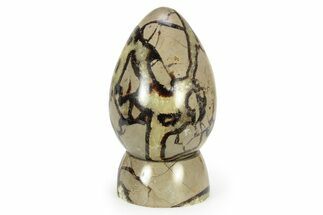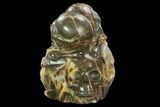This Specimen has been sold.
4.4" Septarian Nodule With Three Carved Skulls
This is an interesting polished skull sculpture that was crafted from a calcite crystal filled septarian geode. This sculpture features three skulls and bone pieces that are scattered throughout the septarian. The septarian comes from the Betsiboka Region of Madagascar and was deposited during the Jurassic period. The polishing reveals the beautiful patterns of the septarian formation and the carving is quite intricate. There are multiple cavities throughout this specimen, all of which are encrusted in nicely preserved calcite crystals. The base is flat, allowing for aesthetic presentation of this sculpture without the need for a display stand.
About Septarian
Septarian or septarian nodules are concretions containing angular cavities or cracks, called "septaria", filled with calcite and aragonite. A concretion is a hard, compact mass of rock that often forms around decaying organic matter. In the case of septarian nodules, the concretions formed around decaying sea life in a marine environment.
The exact mechanism for how the cracks form in the concretions is a mystery. One possible mechanism is the dehydration of the clay-rich core of a concretion, causing it to shrink and crack. The cracks could also be caused by gas expansion produced by the decaying organic matter within a concretion. Earthquakes have also been suggested as yet another mechanism.
The cracks in the concretions are then filled in with minerals such as calcite (yellow), aragonite (brown), and sometimes pyrite, causing very interesting patterns. They have often been described as looking like dragon's skin. They are frequently found as geodes with hollow, calcite crystal-filled cavities. More rarely, the fossils that originally started the formation of the concretion are still preserved in the septarian.
Septarian or septarian nodules are concretions containing angular cavities or cracks, called "septaria", filled with calcite and aragonite. A concretion is a hard, compact mass of rock that often forms around decaying organic matter. In the case of septarian nodules, the concretions formed around decaying sea life in a marine environment.
The exact mechanism for how the cracks form in the concretions is a mystery. One possible mechanism is the dehydration of the clay-rich core of a concretion, causing it to shrink and crack. The cracks could also be caused by gas expansion produced by the decaying organic matter within a concretion. Earthquakes have also been suggested as yet another mechanism.
The cracks in the concretions are then filled in with minerals such as calcite (yellow), aragonite (brown), and sometimes pyrite, causing very interesting patterns. They have often been described as looking like dragon's skin. They are frequently found as geodes with hollow, calcite crystal-filled cavities. More rarely, the fossils that originally started the formation of the concretion are still preserved in the septarian.
SPECIES
Septarian & Calcite
LOCATION
Ambondromamy, Betsiboka Region, Madagascar
SIZE
4.4 x 3.5"
CATEGORY
ITEM
#127609
 Reviews
Reviews

















